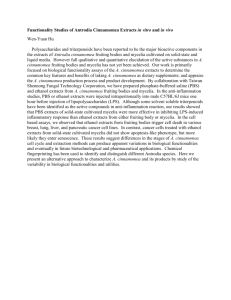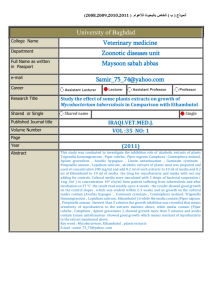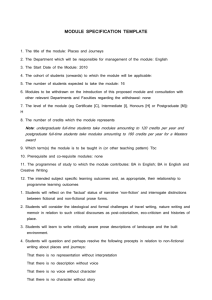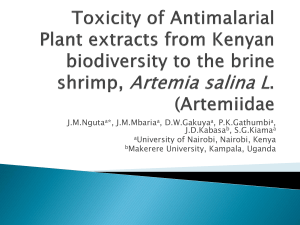in vitro antioxidant activities of leaf and root extracts of albizia
advertisement
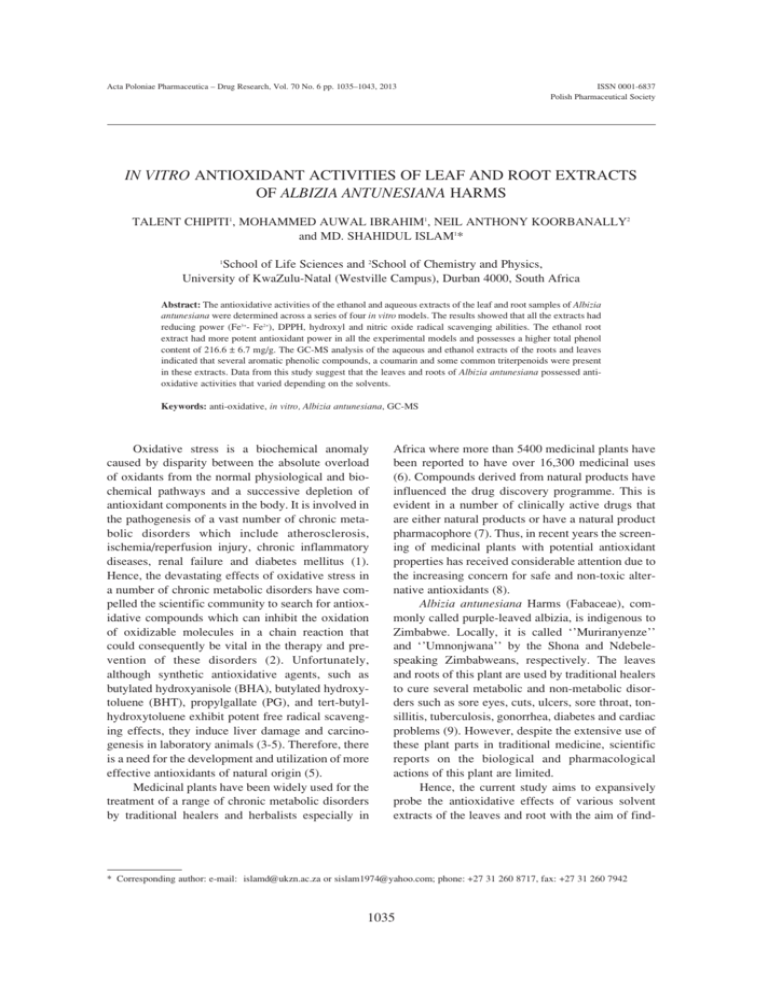
Acta Poloniae Pharmaceutica ñ Drug Research, Vol. 70 No. 6 pp. 1035ñ1043, 2013 ISSN 0001-6837 Polish Pharmaceutical Society IN VITRO ANTIOXIDANT ACTIVITIES OF LEAF AND ROOT EXTRACTS OF ALBIZIA ANTUNESIANA HARMS TALENT CHIPITI1, MOHAMMED AUWAL IBRAHIM1, NEIL ANTHONY KOORBANALLY2 and MD. SHAHIDUL ISLAM1* School of Life Sciences and 2School of Chemistry and Physics, University of KwaZulu-Natal (Westville Campus), Durban 4000, South Africa 1 Abstract: The antioxidative activities of the ethanol and aqueous extracts of the leaf and root samples of Albizia antunesiana were determined across a series of four in vitro models. The results showed that all the extracts had reducing power (Fe3+- Fe2+), DPPH, hydroxyl and nitric oxide radical scavenging abilities. The ethanol root extract had more potent antioxidant power in all the experimental models and possesses a higher total phenol content of 216.6 ± 6.7 mg/g. The GC-MS analysis of the aqueous and ethanol extracts of the roots and leaves indicated that several aromatic phenolic compounds, a coumarin and some common triterpenoids were present in these extracts. Data from this study suggest that the leaves and roots of Albizia antunesiana possessed antioxidative activities that varied depending on the solvents. Keywords: anti-oxidative, in vitro, Albizia antunesiana, GC-MS Oxidative stress is a biochemical anomaly caused by disparity between the absolute overload of oxidants from the normal physiological and biochemical pathways and a successive depletion of antioxidant components in the body. It is involved in the pathogenesis of a vast number of chronic metabolic disorders which include atherosclerosis, ischemia/reperfusion injury, chronic inflammatory diseases, renal failure and diabetes mellitus (1). Hence, the devastating effects of oxidative stress in a number of chronic metabolic disorders have compelled the scientific community to search for antioxidative compounds which can inhibit the oxidation of oxidizable molecules in a chain reaction that could consequently be vital in the therapy and prevention of these disorders (2). Unfortunately, although synthetic antioxidative agents, such as butylated hydroxyanisole (BHA), butylated hydroxytoluene (BHT), propylgallate (PG), and tert-butylhydroxytoluene exhibit potent free radical scavenging effects, they induce liver damage and carcinogenesis in laboratory animals (3-5). Therefore, there is a need for the development and utilization of more effective antioxidants of natural origin (5). Medicinal plants have been widely used for the treatment of a range of chronic metabolic disorders by traditional healers and herbalists especially in Africa where more than 5400 medicinal plants have been reported to have over 16,300 medicinal uses (6). Compounds derived from natural products have influenced the drug discovery programme. This is evident in a number of clinically active drugs that are either natural products or have a natural product pharmacophore (7). Thus, in recent years the screening of medicinal plants with potential antioxidant properties has received considerable attention due to the increasing concern for safe and non-toxic alternative antioxidants (8). Albizia antunesiana Harms (Fabaceae), commonly called purple-leaved albizia, is indigenous to Zimbabwe. Locally, it is called ëíMuriranyenzeíí and ëíUmnonjwanaíí by the Shona and Ndebelespeaking Zimbabweans, respectively. The leaves and roots of this plant are used by traditional healers to cure several metabolic and non-metabolic disorders such as sore eyes, cuts, ulcers, sore throat, tonsillitis, tuberculosis, gonorrhea, diabetes and cardiac problems (9). However, despite the extensive use of these plant parts in traditional medicine, scientific reports on the biological and pharmacological actions of this plant are limited. Hence, the current study aims to expansively probe the antioxidative effects of various solvent extracts of the leaves and root with the aim of find- * Corresponding author: e-mail: islamd@ukzn.ac.za or sislam1974@yahoo.com; phone: +27 31 260 8717, fax: +27 31 260 7942 1035 1036 TALENT CHIPITI et al. ing compounds that might be valuable in ameliorating oxidative stress mediated chronic metabolic disorders as well as validating, in part, the traditional use of this plant in the treatment and management of a vast array of chronic metabolic disorders. MATERIALS AND METHODS Chemicals and reagent Gallic acid, ascorbic acid, 1,1-diphenyl-2picrylhydrazyl radical (DPPH), 2-deoxy-D-ribose, ferric chloride (FeCl3), sodium carbonate, trichloroacetic acid (TCA), EDTA, H2O2 and potassium ferricyanide were procured from Sigma-Aldrich through Capital Lab Supplies, New Germany, South Africa. Griess reagent, sodium nitroprusside, thiobarbituric acid (TBA) and Folin-Ciocalteau reagent were purchased from Merck Chemical Company, Durban, South Africa. Plant material The fresh leaves and root samples of Albizia antunesiana were collected in the month of March, 2012 from Mrewa, Mashonaland East province, Zimbabwe. The plant samples were identified and authenticated by the herbarium unit of the Harare Botanical Garden and Herbarium, Harare, Zimbabwe and a voucher specimen number AA31509 was deposited accordingly. The leaves and roots were immediately washed with distilled water, cut into small pieces and shade-dried until constant weight was attained. The dried samples were ground to a fine powder using a blender, and stored individually in air-tight Ziploc bags for transporting to the University of KwaZulu-Natal, Westville campus, Durban, South Africa for further analysis. Preparation of the plant extracts Forty grams of the finely powdered plant parts were separately defatted with hexane. The defatted materials were sequentially extracted with ethanol and water by soaking for 48 h in 200 mL of the respective solvent. The ethanol extracts were filtered and evaporated under reduced pressure using a rotary evaporator (Buchi rotavapor II) at 40OC. Aqueous extracts were dried using a freeze dryer. The solvent extracts in each case was weighed, transferred to microtubes and stored in a refrigerator at 4OC until required. Estimation of total phenolic content The total polyphenol content of each extract was determined (as gallic acid equivalent) according to the method described by McDonald et al. (10) with slight modifications. Briefly, 200 µL of the extract (240 µg/mL) was incubated with 1 mL of ten-fold diluted Folin-Ciocalteau reagent and 800 µL of 0.7 M Na2CO3 for 30 min at room temperature. At the end of the incubation, absorbance values were determined at 765 nm on a Shimadzu UV mini 1240 Spectrophotometer (Shimadzu Corporation, Kyoto, Japan). All measurements were done in triplicate. The concentration of polyphenol was directly proportional to the absorbance of sample. Ferric (Fe3+) reducing antioxidant power assay (FRAP) The FRAP method of Oyaizu (11) with slight modifications was used to measure the reducing capacity of the extracts. To perform this assay, 1 mL of different extract concentrations (15ñ240 µg/mL) were incubated with 1 mL of 0.2 M sodium phosphate buffer (pH 6.6) and 1% potassium ferricyanide at 50OC for 30 min. After 30 min incubation, the reaction mixture was acidified with 1 mL of 10% trichloroacetic acid. Thereafter, 1 mL of the acidified sample of this solution was mixed with 1 mL of distilled water and 200 µL of FeCl3 (0.1%) in another test tube and the absorbance was measured at 700 nm. Increased absorbance of the reaction mixture indicates a higher reduction capacity of the extracts which was calculated according to the following formula: Absorbance of sample Ferric reducing antioxidant power (%) = óóóóóóóóóóóó ◊ 100 Absorbance of gallic acid Free radical scavenging activity (DPPH assay) The free radical scavenging activity of the extracts was determined and compared to that of ascorbic and gallic acids by using a method described by Tuba and Gulcin (12) with slight modifications. In order to perform this assay, a 0.3 mM solution of DPPH was prepared in methanol and 500 µL of this solution was added to 1 mL of the extract at different concentrations (15ñ240 µg/mL). These solutions were mixed and incubated in the dark for 30 min at room temperature. The absorbance was measured at 517 nm against a blank, lacking the scavenger. The scavenging effects of the solvent extracts in the DPPH assay (including hydroxyl and nitric oxide radicals) were calculated according to the following equation: Ac - As Scavenging activity (%) = (óóóóóó) ◊ 100 Ac where: Ac = the absorbance of control and As = the absorbance of sample or standard. In vitro antioxidant activities of leaf and root extracts of Albizia antunesiana harms Hydroxyl radical scavenging (HRS) assay (deoxyribose method) The hydroxyl radical scavenging activity was measured by studying the competition between deoxyribose and the solvent extracts for hydroxyl radicals generated by the ascorbateñEDTAñH2O2 system (Fenton reaction) as described by Hinnerburg et al. (13). The assay was performed by adding 200 µL of premixed 100 µM FeCl3 and 100 µM EDTA (1 : 1, v/v) solution, 100 µL of 10 mM H2O2, 360 µL of 10 mM 2-deoxy-D-ribose, 1 mL of different extract concentrations (15ñ240 µg/mL), 400 µL of 50 mM sodium phosphate buffer (pH 7.4) and 100 µL of 1 mM ascorbic acid in sequence. The mixture was incubated at 50OC for 2 h. Thereafter, 1 mL of 2.8% TCA and 1 mL of 1.0% TBA (in 0.025 M NaOH) were added to each test tube. The samples were further incubated in a water bath at 50OC for 30 min to develop the pink chromogen color. The extent of oxidation was estimated from the absorbance of the solution at 532 nm and the hydroxyl radical scavenging activity of the extract is reported as a percentage inhibition of deoxyribose degradation. Nitric oxide (NO) radical scavenging assay Sodium nitroprusside in aqueous solution at physiological pH spontaneously generates nitric oxide (NO), which interacts with oxygen to produce nitrite ions that can be estimated by use of Griess reagent. Scavengers of NO compete with oxygen, leading to reduced production of NO. The assay was carried out by incubating 500 µL of 10 mM sodium nitroprusside in phosphate buffer (pH 7.4) and 500 µL of different extract concentrations (15-240 µg/mL) at 37OC for 2 h. The reaction mixture was then mixed with 500 µL of Griess reagent. The absorbance of the chromophore formed during the diazotization of nitrite with sulfanilamide and subsequent coupling with naphthylethylenediamine was read at 546 nm. The percentage inhibition of nitric oxide generated was measured in comparison with the absorbance value of a control (sodium nitroprusside in phosphate buffer). Gas chromatography-mass spectrometric (GCMS) analysis The aqueous and ethanol extracts of the leaf and root samples of the plant were subjected to GCMS analysis. The analysis was conducted with an Agilent Technologies 6890 Series GC apparatus coupled with an Agilent 5973 mass selective detector and driven by Agilent chemstation software. A HP-5MS capillary column was used (30 m ◊ 0.25 mm internal diameter, 0.25 µm film thickness). The carrier gas was ultra-pure helium at a flow rate of 1.0 mL/min and a linear velocity of 37 cm/s. The injector temperature was set at 250OC. The initial oven temperature was set at 60OC which was programmed to increase to 280OC at the rate of 10OC/min with a hold time of 4 min at each increment. Injections of 2 µL were made in the splitless mode with a split ratio of 20 : 1. The mass spectrometer was operated in the electron ionization mode at 70 eV and electron multiplier voltage at 1859 V. Other MS operating parameters were as follows: ion source temperature 230OC, quadrupole temperature 150OC, solvent delay 4 min and scan range 50-700 amu. The compounds were identified by direct comparison of the retention times and mass spectral data and fragmentation pattern with those in the National Institute of Standards and Technology (NIST) library. Table 1. Percentage recovery (g/g) and total phenolics content of various solvent extracts of A. antunesiana parts % recovery (g/g) Total polyphenol (mg/g GAE) EtOH 4.36 Aqueous 4.79 134.3 ± 13.5b 121.5 ± 13.5b Samples Leaves Root EtOH 1.59 Aqueous 7.10 1037 216.6 ± 6.7c 109.1 ± 6.2a Data are presented as the mean ± SD values of triplicate determinations. a-cDifferent superscript letters for a given value within a column are significantly different from each other (Tukeyís-HSD multiple range post-hoc test, p < 0.05) 1038 TALENT CHIPITI et al. Statistical analysis All data are presented as the mean ± SD of triplicates determination. Data were analyzed by SPSS statistical software (version 19) using Tukeyís multiple range post-hoc test. Values were considered significantly different at p < 0.05. RESULTS The percentage recovery (g/g) obtained from various extracts (Table 1) collected from the plant indicated that the highest recovery was obtained in the aqueous extracts. All extracts were found to possess a high total phenolic content. However, the highest total phenolic content was recorded in the ethanol extract of the roots (Table 1). Table 2 shows the total reducing power of the ethanol and aqueous extracts of A. antunesiana parts. All the extracts showed an ability to donate electrons to convert Fe3+ into Fe2+ as indicated by the concentration dependent increase in the percentage reducing power. The ethanol extract of the root had a significantly (p < 0.05) higher total reducing power than other extracts. Figure 1 shows the DPPH radical scavenging activities of the leaf (A) and root (B) extracts of A. antunesiana parts. All the extracts showed an ability to quench DPPH free radicals as indicated by the concentration dependent increase in the percentage inhibition. The root extracts had a consistently higher DPPH radical scavenging activity, which is concentration dependent (Fig. 1). The results of the HRS scavenging activities of the plant extracts are shown in Table 3, which indicated that all (ethanol and aqueous) extracts could scavenge hydroxyl radicals generated by Fentonís Figure 1. DPPH radical scavenging activity of ethanol and aqueous extracts of the leaves (A) and root (B) of A. antunesiana. Data are presented as the mean ± SD of triplicate determinations. a-e Values with different letters over the bars for a given concentration of each extract are significantly different from each other (TukeyísHSD multiple range post-hoc test, p < 0.05). 1039 In vitro antioxidant activities of leaf and root extracts of Albizia antunesiana harms Table 2. Percentage of total reducing power (GAE) of solvent extracts from various parts of A. antunesiana Concentration (µg/mL) Extracts 15 30 60 120 240 Leaves EtOH 16.38 ± 1.30a 21.19 ± 2.45a 26.37 ± 1.33b 27.93 ± 1.14a 49.85 ± 9.07a Aqueous 8.91 ± 3.39 12.62 ± 4.54 14.50 ± 0.88 a 18.12 ± 5.69 39.13 ± 1.00b EtOH 36.08 ± 1.12b 49.47 ± 2.66b 50.64 ± 0.45c 54.89 ± 2.39b 85.76 ± 1.05b Aqueous 11.46 ± 2.02a 21.04 ± 0.20a 25.18 ± 0.63b 32.71 ± 1.80b 49.21 ± 1.10b 76.83 ± 4.92c 80.24 ± 3.00c 90.26 ± 5.51d 91.08 ± 5.43b 93.60 ± 6.21b a a a Root Standard Ascorbic acid Data are presented as the mean ± SD values of triplicate determinations. a-d Different superscript letters for a given value within a column are significantly different from each other (Tukeyís-HSD multiple range post-hoc test, p < 0.05). Table 3. Percentage hydroxyl radical scavenging activity of extracts from the root and leaves of A. antunesiana. Concentration (µg/mL) Extracts 15 30 60 120 240 Leaves Ethanol 34.96 ± 0.04d 51.63 ± 0.05d 56.00 ± 0.51d 65.67 ± 1.40d 83.00 ± 2.00c Aqueous 4.76 ± 1.83 8.90 ± 4.22 13.09 ± 4.11 a 18.42 ± 3.10 26.87 ± 8.10a Ethanol 22.50 ± 2.33c 29.00 ± 1.94c 40.04 ± 0.53d 56.90 ± 0.40d 63.00 ± 0.50d Aqueous 0.80 ± 0.05a 2.50 ± 0.92a 5.50 ± 3.40a 13.30 ± 0.73a 27.60 ± 0.71a a a a Root Standards Ascorbic acid 14.50 ± 2.20b 17.35 ± 3.10b 21.85 ± 0.10b 26.80 ± 0.70b 30.30 ± 1.20a Gallic acid 32.00 ± 0.60 35.57 ± 2.30 36.75 ± 1.80 38.90 ± 1.10 40.20 ± 0.20c d d c c Data are presented as the mean ± SD values of triplicate determinations. a-iDifferent superscript letters for a given value within a column are significantly different from each other (Tukeyís-HSD multiple range post-hoc test, p < 0.05). reaction with the ethanol extracts displaying significantly higher scavenging abilities compared to the aqueous extracts and the standards used (Table 3). It is also notable that the ethanol extract of the leaf consistently demonstrated a significantly higher (p < 0.05) HRS activity than all other extracts. Table 4 presents the NO scavenging activities of ethanol and aqueous extracts of A. antunesiana leaves and roots. All the extracts were found to exhibit NO inhibition activity but the ethanol extract of the leaves demonstrated a higher NO inhibition effect than other extracts. Furthermore, the ethanol extracts of the leaves and roots possessed lower IC50 values of 20.42 and 15.95 µg/mL respectively, than the corresponding aqueous extracts in these plant parts (Table 5). The list of isolated compounds from the different section of the plant is shown in Table 6 with their corresponding retention times and molecular masses. The major compounds found in the different sections of the plan are listed in Figure 2 and 3. DISCUSSION Albizia antunesiana is used by traditional healers and herbalist to treat and manage non metabolic chronic disorders in Mrewa district Zimbabwe (personal communication with traditional healers). The genus Albizia comprises over 150 species across the world with many species being used for medicinal purposes but only a few have been investigated for biological activities (14). In this study, we deter- 1040 TALENT CHIPITI et al. mined the complete anti-oxidative profile of the ethanol and aqueous extracts from the leaves and roots as a lead in the search for extracts with potential compounds that could be useful in alleviating oxidative stress-associated complications. Our findings also indicate that some A. antunesiana extracts possess exceptionally high antioxidative activities, as proven by the in vitro experimental models. In the present study, the set of in vitro assays were employed to cover all possible known mechanisms by which different antioxidants operate to inhibit oxidative chain reactions since there is no single model known to mimic all oxidative pathways. The ferric reducing antioxidant assay (FRAP) which measures the total reducing ability was meas- ured as ferric (Fe3+) to ferrous (Fe2+) conversion in the presence of the extracts using the protocol of Oyaizu (11). This assay is relevant due to its ability to assess the extract potential to facilitate the conversion of (Fe3+) to (Fe2+). The extent to which it promotes this reduction process will indicate how effective the extract is as an antioxidant compound. The significantly (p < 0.05) higher antioxidant ability indicated by the ethanol extract of the root and leaf samples indicate that the phytochemical components with high redox potential in these plant parts are more soluble in ethanol than in water. DPPH is a stable molecule consisting of a nitrogen-centered free radical with characteristic color changes from violet to yellow upon reduction Table 4. Percentage NO scavenging activities of extracts from various parts of A. antunesiana. Concentration (µg/mL) Extracts 15 30 60 120 240 Ethanol 49.27 ± 0.80b 49.36 ± 1.50b 55.47 ± 0.40c 55.47 ± 0.30b 56.99 ± 0.21b Aqueous 16.80 ± 1.20a 28.00 ± 0.90a 33.6 ± 0.70a 35.11 ± 0.70a 43.51 ± 2.20a Ethanol 28.24 ± 1.60b 37.15 ± 1.30b 43.66 ± 0.80c 46.54 ± 0.70c 58.57 ± 1.10c Aqueous 25.44 ± 6.30 36.64 ± 2.70 39.44 ± 0.70 c 42.23 ± 0.90 55.21 ± 0.20c Ascorbic acid 51.44 ± 0.05b 56.94 ± 0.90b 58.37 ± 1.40c 62.44 ± 0.70b 77.22 ± 1.20c Gallic acid 43.06 ± 9.20b 47.36 ± 0.70b 49.76 ± 0.70b 59.33 ± 3.20b 64.59 ± 6.20b Leaves Root b b c Standards Data are presented as the mean ± SD values of triplicate determinations. a-iDifferent superscripts letters for a given value within a column are significantly different from each other (Tukeyís-HSD multiple range post-hoc test, p < 0.05). Table 5. IC50 values of various solvent extracts of A. antunesiana parts in different antioxidative models. IC50 (µg/mL) Samples DPPH HRS NO Ethanol 42.65 34.67 20.42 Aqueous 45.70 6.02* 501.18 Leaves Root Ethanol 7.08 97.72 15.95 Aqueous 12.58 4.36* 223.87 Ascorbic acid 5.01 64.65 15.13 Gallic acid 5.62 6.30* 41.68 Standards The * represents the units of these values which are in mg/mL. In vitro antioxidant activities of leaf and root extracts of Albizia antunesiana harms 1041 Table 6. Identified compounds of EtOH and aqueous extracts of different parts of A.antunesiana by GC-MS. Retention time (min) Molecular mass (g/mol) 7.69 118.13 Catechol 7.66 110.10 Resorcinol 8.69 110.10 Compounds Ethanol extract Leaves Benzofuran Roots Pyrogallol 9.91 126.11 α-Amyrin 22.63 426.73 β-Amyrin 22.63 426.73 Benzofuran 7.69 118.13 Methyl mannitol 10.55 126.11 Pyrogallol 18.03 262.30 7.75 110.1 Aqueous extract Leaves Root Catechol Resorcinol 8.81 110.1 Pyrogallol 10.12 126.11 Figure 2. Phenolic compounds identified in the root and leaf extracts of Albizia antunesiana Figure 3. Hydrogen radical donation to a reactive radical species and stabilization of the resultant radical by either the process of hydrogen- or electron- donation. The degree of the reduction is reflective of the radical scavenging (antioxidant) power of the com- pound (13). The results of the DPPH assay of the aqueous and ethanol extracts of the leaves and roots revealed that virtually all extracts possessed stronger 1042 TALENT CHIPITI et al. free radical scavenging potential compared to gallic and ascorbic acids. However, the IC50 values indicated the best free radical scavenger to be ethanol root extracts because of the low value of 7.08 µg/mL which is in the same range with that of ascorbic and gallic acids. This could further indicate that these extracts contain powerful free radical scavenging phytochemicals that might have the potential to inhibit free radical accumulation which usually build up in chronic metabolic disorders and therefore could be useful therapeutic agents for treating free radical linked pathological conditions. The hydroxyl radicals are highly reactive free radicals formed in biological systems and has been implicated as a highly damaging species in free radical pathology, capable of damaging almost every molecule found in living systems (15). The hydroxyl radical can target and damage virtually all types of major macromolecules: carbohydrates, nucleic acids (mutations), lipids (lipid peroxidation) and amino acids (16). Henceforth, the identification of plant extracts which exhibit high hydroxyl radical quenching potential will be useful for the prevention of the hydroxyl radical-mediated destruction of biological molecules against oxidative stress related diseases. The hydroxyl radical scavenging activity was measured as the percentage inhibition power of the extracts towards hydroxyl radicals generated from the Fentonís reaction mixture by studying the competition between deoxyribose and the extract for hydroxyl radicals generated from Fe3+/ascorbate/ EDTA/H2O2 systems (17). Our results indicated that all extracts had a potential to scavenge hydroxyl radicals. However, the ethanol extracts have proven, at least under in vitro conditions, to contain better antioxidants for use against diseases where the hydroxyl radical upsurge is an important mechanism for pathogenesis. Nitric oxide, a chemical mediator generated by endothelial cells, macrophages, and neurons is involved in a variety of physiological processes (18). Excess concentration of nitric oxide is associated with a number of diseases (19). Oxygen reacts with excess nitric oxide to form nitrite and peroxynitrite ions, which act as free radicals. Our present study indicated that all the extracts have a competing power with oxygen to react with nitric oxide and thus inhibition of anions to some extent, which varies across different extracts. All the extracts did not show much promising nitric oxide scavenging ability as compared to other antioxidant activities. This difference can be accounted for by the way in which the nitric oxide radicals are generated and the different physical and chemical properties of the antioxidants contained in the extracts (20). The difference in antioxidant activity using different stable radicals Fe2+/Fe3+ might be influenced by different redox potentials and steric properties (21). GC-MS analysis of the aqueous and ethanol extracts of the leaves and roots were carried out in order to identify the presence of aromatic and phenolic compounds capable of having antioxidant activity. Two isomers of benzenediol (catechol and resorcinol) and two isomers of benzenetriol (pyrogallol and hydroxyquinol) were identified in the extracts by comparing their MS spectra to those of standard spectra from the NIST library. Catechol, pyrogallol and resorcinol were found in the ethanol and aqueous extracts of the roots while pyrogallol and hydroxyquinol were found in the aqueous extract of the leaves. In addition, coumarin was found in the ethanol and aqueous extracts of the leaves and α- and β-amyrin, two well know triterpenoid natural products were detected in the ethanol extracts of the roots. Phenolic compounds such as those described here (Fig. 2) are capable of donating a hydrogen radical or an electron to quench radicals as the resultant aromatic radicals are able to be stabilized by delocalization of the resultant radical on the benzene ring (Fig. 3). Overall, we concluded that the observed antioxidant activity with the EtOH root extract might be linked to the high phenolic content which has been shown by the higher activity of this extract. The ethanol root extract has indicated remarkably higher activities across in vitro antioxidant models used, which could prompt more studies to be done in order to identify and purify the active compounds and their underlying mechanisms. Furthermore, the results displayed by the ethanol root extract are interesting enough to be used in in vivo models. Interestingly, findings from this study also support the use of the root by traditional healers in the Mrewa district as medicine. Acknowledgments This study was supported by the competitive research grant from the Research Office, University of KwaZulu-Natal (UKZN), Durban; an incentive grant for rated researchers and a grant support for women and young researchers from the National Research Foundation (NRF), Pretoria, South Africa. The first author received a scholarship from the College of Agriculture, Engineering and Science, University of KwaZulu-Natal, South Africa. In vitro antioxidant activities of leaf and root extracts of Albizia antunesiana harms REFERENCES 1. Calabrese V., Cornelius C., Leso V., TrovatoSalinaro A., Ventimiglia B., Cavalloaro M., Scuto M. et al.: Biochim. Biophys. Acta 1822, 729 (2012). 2. Wright E. J., Scism-Bacon J. L., Glass L. C.: Int. J. Clin. Pract. 60, 308 (2006). 3. Saito M., Sakagami H., Fujisawa S.: Cytotoxicity and apoptosis induction by BHA and BHT. Anti-Cancer Res. 23, 4693 (2003). 4. Subhasree B., Baskar R., Laxmi Keerthana R., Lijina Susan R., Rajasekaran P.: Food Chem. 115, 1213 (2009). 5. Djeridane A., Yousfi M., Brunel J. M., Stocker P.: Food Chem. Toxicol. 48, 2599 (2010). 6. van Wyk B.E.: J. Ethnopharmacol. 119, 342 (2008). 7. Koehn F.E., Carter G.T.: Nat. Rev. Drug Disc. 4, 206 (2005). 8. Aliyu A.B., Ibrahim M.A., Musa A.M., Bulus T., Oyewale A. O.: Int. J. Biol. Chem. 5, 352 (2011). 9. Gelfand M., Mavi S., Drummond R.B., Ndemera B.: The traditional medical practitioner in Zimbabwe. Zimbabwe: his principles of practice and pharmacopoeia. Mambo Press, Gweru, Zimbabwe. p. 411 (1985). 1043 10. McDonald S., Prenzler P.D., Autolovich M., Robards K.: Food Chem. 73, 73 (2001). 11. Oyaizu M.: Jap. J. Nutr. 44, 307 (1986). 12. Tuba K., G¸lÁin I.: Chemico-Biol. Interact. 174, 27 (2008). 13. Hinnerburg I., Damien H.J., Hiltumen R.: Food Chem. 97, 122 (2006). 14. Singh A.N., Raghubansi A.S., Singh J.S.: Ecol. Eng. 22, 123 (2004). 15. Ibrahim M. A., Koorbanally N. A., Kiplimo J. J., Islam M. S.: J. Med. Plant Res. 6, 4176 (2012). 16. Pastor N., Weinstein H., Jamison E., Brenowitz M.: J. Mol. Biol. 304, 55 (2000). 17. Dunford H. B.: Coord. Chem. Rev. 233/234, 311 (2002). 18. Lata H., Ahuja G.K.: Indian J. Physiol. Allied Sci. 57, 124 (2003). 19. Ross R.: Nature 362, 801 (1993). 20. Schwarz K., Bertelsen G., Nissen L. R., Gardner P. T., Heinonen M. I., Hopia I., HuynhBa T. et al.: Eur. Food Res. Technol. 212, 319 (2001). 21. Gardner P. T., Mcphail D., Duthie G. G.: J. Food Sci. Agric. 76, 257 (1998). Received: 08. 04. 2013


